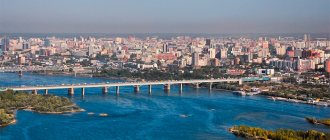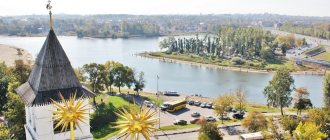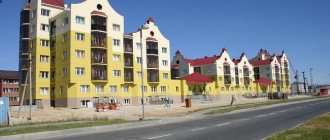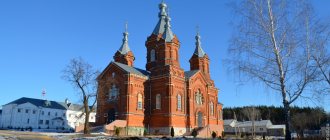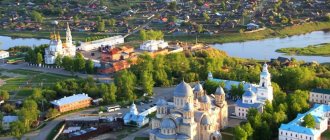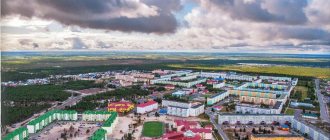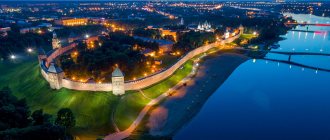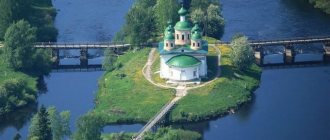Founded: 1716
Kolchak's house in Omsk
Omsk
- a Russian city, the center of the Omsk region, located at the intersection of the Trans-Siberian Railway and the Irtysh River.
In 1716
By order of Peter I, a fortress was founded at the mouth of the Om River. This fortress became known as Omsk. In 1771, a new fortress was built on the right bank of the Om. In August 1782, the Omsk fortress became a settlement of the Tobolsk governorship, and in October it was given the status of a city.
In 1822, Omsk became the main city of Western Siberia, the Tobolsk, Tomsk provinces and the Semipalatinsk region were subordinate to it. In March 1896, a bridge was built across the Irtysh, and train traffic began from Chelyabinsk to Novonikolaevsk (Novosibirsk).
In 1918-1919, the city of Omsk was the residence of Admiral A.V. Kolchak, who declared Omsk the capital of Siberia.
In 1927, the first zoo in Siberia opened here.
In 1934, the All-Russian Central Executive Committee decided to form the Omsk region with its center in Omsk. In 1941, monuments of ancient art were brought from Novgorod to the Omsk Museum of Local Lore for the duration of the war - the Korsun and Sigtuna (Magdeburg) gates, removed from the St. Sophia Cathedral.
House of the Elvorti Society During the Great Patriotic War, about 100 industrial enterprises were evacuated to Omsk and the Omsk region. On March 12, 1954, a meeting and meeting of the first echelon of Moscow youth, who arrived in the Omsk region to develop virgin lands, took place at the railway station.
In July 1993, Omsk was visited by members of the royal family - the Head of the Imperial House of the Romanov dynasty, Maria Vladimirovna and her son Georgy Mikhailovich.
Currently, Omsk is a large scientific and educational center. 44 organizations are involved in scientific developments; higher education is represented by 20 universities. Various types of industry are widely represented in the city. Due to its geographical location, Omsk is a major transport hub. The city is experiencing demographic growth and massive housing construction is underway.
By Decree of the President of the Russian Federation dated July 2, 2022, Omsk was awarded the honorary title of Russian Federation for the significant contribution of city residents to achieving Victory in the Great Patriotic War of 1941–1945, ensuring uninterrupted production of military and civilian products at industrial enterprises, and for the massive labor heroism and dedication shown. Federation " City of Labor Valor"
».
Monument to the plumber in the center of Omsk
The landmarks of
Omsk are the General Governor's Palace, now the Vrubel Museum of Fine Arts, the Assumption Cathedral, the Omsk Academic Drama Theater, the Elvorti House, the Kolchak House.
Interesting,
that on December 5, 1997, Omsk received documents for the right to own the small planet “Omsk”.
The city has a population of about 1,140 thousand people (2020).
Day of the city
celebrated on the first weekend of August. But in 2022, due to the coronavirus pandemic, the festive events were postponed to September.
Current data
The population as of 2022 is 1,154,507. Moreover, according to statistics, up to 60 percent of all residents of the Omsk region live in the city.
In addition, compared to previous years, the birth rate in Omsk has increased significantly, and the death rate has decreased. Previously, the main reason for the increase was considered to be migration of residents of the CIS countries. This is true for now, but soon, if the birth rate continues to rise, natural increase will prevail.
Coat of arms
The coat of arms of Omsk is presented in the form of a blue-silver French shield. It is crowned with a golden tower crown with five prongs. It is surrounded by a laurel wreath and a ribbon of the Order of the Red Banner of Labor.
The silver field depicts a red wall with small triangular bastions. The structure is supported by a fusilier from the times of Peter the Great with a baguette and a Siberian Cossack from the times of Catherine the Great with a musket and saber standing on a marble base. The motto: “HE IS THE MAIN FORTRESS” is inscribed on the ribbon.
The artistic composition was adopted by decision of the Omsk City Council dated April 16, 2014 No. 221.
Statistics by year
Population growth is constantly rising and falling. At the same time, since 1979, it has never lost its status as a million-plus city. As of 2022, Omsk was in 8th place out of 1115 in terms of the number of people living on its territory. City population statistics by year (starting from 2010):
- 2010 – 1,154,116 people.
- 2011 – 1,154,121 hours
- 2012 – 1,156,583 hours
- 2013 – 1,160,670 hours
- 2014 – 1,166,092 hours.
- 2015 – 1,173,854 hours
- 2016 – 1,178,079 hours
- 2017 – 1,178,391 hours
- 2018 – 1,172,070 hours
- 2019 – 1,164,815 hours
- 2020 – 1,154,507 hours
L. G. Polishchuk
| Polishchuk Lyubov Grigorievna (May 21, 1949, Omsk - November 28, 2006, Moscow), Russian actress, People's Artist of Russia (1994). In 1985 graduated from GITIS named after. A. V. Lunacharsky. She worked at the Moscow theater "School of Modern Play". On stage, she enjoyed particularly great success in the role of Natalya Stepanovna in the eccentric play “Why are you in a tailcoat.” Plasticity, bright expressiveness, and the ability to transform allow Polishchuk to brilliantly cope with screen roles of various genres (“Intergirl” by P. E. Todorovsky, 1989, “My Sailor Girl” by A. N. Eiramdzhan, “Shirli Myrli” by V. V. Menshov, 1995), etc. She also starred in the films “Quadrille” (1998), “Quiet Waters” (2000), the TV series “Russian Amazons 2”, “My Fair Nanny” (2004), etc. |
About the city
For the first time, the Tara governor, Prince Shakhovsky, spoke about building a settlement on the Omi River in 1627. This was due to the fact that the Oirats, a nomadic people living in the southeastern part of Russia, were increasingly improving trade relations with Russia. In addition, further to the east was the Dzungar Khanate, which constantly raided Russian lands. A big blow fell on the volosts of the Tara district. Also, the existing trade route used to transport salt was inconvenient for most traders, since it did not have any transshipment points.
Then, in 1627, Shakhovsky proposed to the Tsar to build a fort on the Om River. He had to solve all the problems listed above. The Cossack leader Nazariy Zhadovsky checked the place where the fort was to be built and found it suitable. The following year, 1628, a new person was appointed to the post of Tara governor - Kaisarov. He also turned to the king with a request to build a fort that would help travelers overcome the Irtysh.
When Peter the Great came to power, giving great preference to the conquest of Siberia, things moved from a dead point. More and more expeditions were sent to Siberia in order to look for deposits of gold and silver. One of the largest expeditions is that of Matvey Gagarin. He went to Siberia with the goal of finding gold mines and also building cities on the Irtysh River. Great importance was given to the first, since after the war with the Swedes Russia experienced economic difficulties.
In July 1715, the expedition set out on a campaign. In the same year, a few months later, the expedition reached the territory of the Oirats and built a fortress there. The locals didn't like it. They believed that the Russians had decided to seize their territories. As a result, the fortress was besieged, which lasted three months. Afterwards the Russians left, and the Oirats destroyed the fortress.
With those who survived the siege, Gagarin moved to the mouth of the Omi River, where he founded a new fortress. In a few years, a second fortress will be founded on the opposite bank of the river.
In the nineteenth century, by decree of the emperor, Omsk became the administrative center of the Akmola region and the West Siberian, and later the Steppe, General Government, which covered a large territory of Western Siberia and part of Kazakhstan.
Dostoevsky was imprisoned in prison for a period from 1850 to 1854. This makes a strong impression on him, which the writer described in the book “Notes from the House of the Dead.” Since Dostoevsky was serving his prison term in Omsk, they decided to name a state university after him in the twenty-first century.
[edit] Notes
| [ + ] Omsk is part of the harsh reality of this country. | |||||||||||||||||
| |||||||||||||||||
Ethnic composition
According to the 2022 census, up to 102 nationalities live in Omsk. Russians predominate (88.8 percent). Next come the Kazakhs (3.4 percent), Ukrainians (2 percent), Tatars (1.9 percent) and Germans (1.3 percent).
Previously, Russians were also the predominant nationality in the city. According to the 1959 census, about 77.43 percent of the total number of living people lived in Omsk (1,645,017 people). Every year the Russian population in the city grew more and more and at the moment there are 88.8 percent of the total number in the city (1,926,665 people).
Transport of Omsk
There are various types of public transport in the city. River transport has a long history and is represented by a river station and a cargo river port.
There are 2 railway stations in the city: “Omsk-Passenger” and “Omsk-Prigorodny”. There is a station square in front of them. Economically important is the passage of the Trans-Siberian Railway through Omsk.
Aviation transport is represented by Omsk-Central Airport. There is also a rather ancient Omsk-Severny airfield, which was previously used for civilian transport.
City transport is represented by all types: buses, trams, trolleybuses and minibuses. The number of bus routes is several times greater than trolleybus and tram routes.
Also, the federal highway “Irtysh” with code number P254 passes through the city.
Gender and age
The population is predominantly female (55 percent). Of the total number of residents, about 20 percent are over working age. According to statistics, the average age of a working Omsk citizen is 35.70 years. Average life expectancy:
- Women – 75.6 years.
- Men - 63 years old.
According to Rosstat data for 2022, there were 1,163 women per 1,000 men.
Economy
Main industries : electric power industry (JSC AK "Omskenergo", 4 thermal power plants); mechanical engineering (PO "Polyot", engine-building enterprise named after P.I. Baranov, OJSC "Omskagregat", "Sibkryotekhnika", "Omskgidroprivod", State Enterprise "Omsk Plant of Lifting Machines", State Unitary Enterprise "Omsktransmash"; production of rockets, engines, grain harvesters ); instrument making (PO Pribor, State Unitary Enterprise Ompo Irtysh, CJSC PO Elektrotochpribor, experienced, OJSC NPK Avtomatika, RELERO; production of televisions, tape recorders, gas equipment); oil refining, chemical and petrochemical (JSC Omsk Oil Product, Sibneft-Omsk Oil Refinery, Omsk Rubber, APO Omskkhimprom, factories - rubber products, plastics, carbon black, paint and varnish "Kolorit"); pharmaceutical (State Unitary Enterprise for the production of bacterial preparations, Federal State Unitary Enterprise "Omsk Bioplant"); production of building materials; woodworking (JSC "Comfort" - furniture factory); light (Bolshevichka clothing factory, Vostok cotton association, Sibirskaya Manufactory OJSC, Omsktrikotazh CJSC, sheepskin and fur production, carpet production, leather and shoe factories), food.
Natural movement
As was written above, recently there has been an increase in the birth rate and a decrease in mortality. However, a natural population decline is still visible. For 2022, the natural decline amounted to 5 thousand people. Experts believe that even with the most optimistic forecast, the population will fall below a million.
In 2015, 16,392 babies were born in the city, which is a record for Omsk. However, in 2022 this figure dropped to 15,982. But, as stated above, mortality still exceeds birth rate. According to forecasts, natural growth, in the most optimistic scenario, will be visible only after about 20 years.
In addition, a high mortality rate among men of working age was observed in the region. According to Rosstat, this is 80 percent of the entire male working population. In women, this figure at the same age is four times lower.
However, the mortality rate of newborns in Omsk is one of the lowest in the entire country (4.7 per 1000 people, compared to 8.5 per 1000 throughout Russia). In addition, this figure is getting lower every year.
Also living in the city is one of Russia’s longest-living women. In 2016, she celebrated her 108th birthday.
Ecological situation
Until 2011, Omsk was considered one of the most polluted cities in the country. However, in recent years the environmental situation has improved. The reason for the improvement was the modernization and slowdown of city enterprises. However, the problem of transport pollution persists. The problem of landfills, which affect river pollution, also remains relevant. The waters of large rivers remain in an unsatisfactory ecological condition.
Migration
And although a year earlier migration was the only source of population growth, in 2022 everything has changed. The level of arrivals has decreased significantly, while the level of departures, on the contrary, has increased. According to Rosstat, there will be 13,513 arrivals in 2022, and 16,327 departures. Of these:
- Within Russia: 11,715/13,633.
- Interregional migration: 4,616/6,534.
- Intraregional: 7,099/7,099.
- International: 1,798/2,688.
Thanks to these data, we can say for sure that in the near future the population of Omsk will definitely not grow due to the influx of migrants, since they, for the most part, leave the region. According to surveys, most of the migrants came to work. The rest are mostly just tourists or exchange students.
Data for the Omsk region
The maximum increase in migration was noted in 2015, when 5.2 thousand people left the city and 12.6 thousand arrived. Then the level of migration gradually fell and reached the value that can be observed now.
Flag
The flag of Omsk is made in the form of a rectangular white panel. The ratio of its sides is 2:3. It consists of three horizontal stripes: red in the center and white along the edges. The latter are equal in size. Medium - 1/4 wide of the same size of the panel. At the top it has seven triangular dents, at the bottom there are the same number of corresponding triangular protrusions. The depth of the depressions and the height of the teeth are 1/12 of the width of the flag.
The artistic composition was accepted on April 16, 2014 and entered into the State Heraldic Register of the Russian Federation under No. 9363.
Forecast
In general, looking at the statistics of past years, we can make the assumption that Omsk will soon experience a natural increase in population. However, it is too early to talk about this now. Experts, however, are pessimistic. According to their forecasts, even if the level of migration and birth rate rises, Omsk will still lose its million-plus status.
However, one thing is known for sure - the mortality rate among Omsk residents is falling, and the birth rate is increasing. In addition, infant mortality is falling. However, there can be no talk of any population growth in the next few years. Now the city still retains its million-plus status only thanks to migrants, whose flow is also decreasing every year.
No one can determine exactly what will happen in the future, so all that remains is to build theories. However, it is worth recognizing that most experts have a positive attitude towards the population of the Omsk region and claim that there will be growth, but not immediately.
Popular message topics
- Pig
The word “pig” will not be offensive if you get to know the wonderful animals with this name. They are not what many people think. Science is now revealing many secrets of one of man’s oldest and wisest friends. - Nettle
Among the numerous representatives of flowering plants, nettle is one of the most common perennial herbaceous plants, which is known to both children and adults. An unpretentious plant can be found everywhere: near residential buildings - Computer internal memory
Internal memory is one of the most important elements of a computer, allowing it to work correctly. It contains information that the computer accesses during operation.
↑ History of the name
It is easy to understand that the name of the city comes from the name of the Om River. In historical terms, this is a relatively young city - it is only about three hundred years old. At the dawn of the development of Siberia, the territory was in great need of protection from attacks by nomadic peoples. Therefore, in 1716, Tsar Peter the Great sent Lieutenant Colonel Buchholz with the task of building a military fortification at the mouth of the Om, at its confluence with the Irtysh. Buchholz's soldiers and Cossacks built a fortress (fortress), it was called Omsk. Faithfully, she served for more than half a century.
